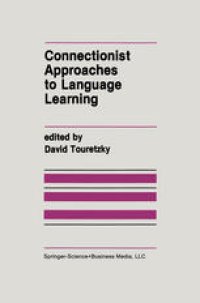
Ebook: Connectionist Approaches to Language Learning
- Tags: Artificial Intelligence (incl. Robotics), Statistical Physics Dynamical Systems and Complexity, Computer Science general
- Series: The Springer International Series in Engineering and Computer Science 154
- Year: 1991
- Publisher: Springer US
- Edition: 1
- Language: English
- pdf
arise automatically as a result of the recursive structure of the task and the continuous nature of the SRN's state space. Elman also introduces a new graphical technique for study ing network behavior based on principal components analysis. He shows that sentences with multiple levels of embedding produce state space trajectories with an intriguing self similar structure. The development and shape of a recurrent network's state space is the subject of Pollack's paper, the most provocative in this collection. Pollack looks more closely at a connectionist network as a continuous dynamical system. He describes a new type of machine learning phenomenon: induction by phase transition. He then shows that under certain conditions, the state space created by these machines can have a fractal or chaotic structure, with a potentially infinite number of states. This is graphically illustrated using a higher-order recurrent network trained to recognize various regular languages over binary strings. Finally, Pollack suggests that it might be possible to exploit the fractal dynamics of these systems to achieve a generative capacity beyond that of finite-state machines.
Content:
Front Matter....Pages i-iv
Introduction....Pages 1-3
Learning Automata from Ordered Examples....Pages 5-34
SLUG: A Connectionist Architecture for Inferring the Structure of Finite-State Environments....Pages 35-56
Graded State Machines: The Representation of Temporal Contingencies in Simple Recurrent Networks....Pages 57-89
Distributed Representations, Simple Recurrent Networks, and Grammatical Structure....Pages 91-121
The Induction of Dynamical Recognizers....Pages 123-148
Back Matter....Pages 149-149
Content:
Front Matter....Pages i-iv
Introduction....Pages 1-3
Learning Automata from Ordered Examples....Pages 5-34
SLUG: A Connectionist Architecture for Inferring the Structure of Finite-State Environments....Pages 35-56
Graded State Machines: The Representation of Temporal Contingencies in Simple Recurrent Networks....Pages 57-89
Distributed Representations, Simple Recurrent Networks, and Grammatical Structure....Pages 91-121
The Induction of Dynamical Recognizers....Pages 123-148
Back Matter....Pages 149-149
....